(Note: Article originally published on Scified, January 22nd, 2015.)
“A rose by any other name would smell as sweet.” - Romeo & Juliet, Act II, Scene II
I highly doubt Godzilla had the same sentiment in Godzilla vs. Biollante, but I enjoy the film enough to call it sweet. It's been just over twenty-five years since it was released (December 16, 1989) and it felt wrong to overlook. For the film's 25th anniversary, film historian Ed Godziszewski was kind enough to share his words and memories about the film. Mr. Godziszewski recorded an audio commentary for the movie's 2012 DVD/Blu-ray release by Echo Bridge. Although it didn't make it on the final disc he’s agreed to talk about his research.
Ed Godziszewski is the current editor and chief of Japanese Giants magazine and has headed the publication since the late 1970s. He's also the author of the excellent The Illustrated Encyclopedia of Godzilla and has contributed his knowledge of the series to G-Fan and Fangoria magazines.
In the mid-2000s he made significant contributions to Classic Media's Godzilla DVD releases. Mr. Godziszewski teamed with Steve Ryfle to supply audio commentaries for Gojira [aka, Godzilla] (1954), the Americanized counterpart Godzilla: King of the Monsters (1956) and Mothra vs. Godzilla (1964). He and Mr. Ryfle also produced the documentary Bringing Godzilla Down to Size which premiered at the American Cinematheque and has been screened at various film schools. It is currently available on Classic Media's Rodan / War of the Gargantuas double feature release.
Godziszewski and Ryfle re-teamed for commentary tracks on Toho's Battle in Outer Space (1959) and Mothra (1961) which are included on Sony's Icons of Sci-Fi: The Toho Collection. The pair are currently collaborating on an Ishiro Honda biography with hopes of releasing it later this year.
As a huge fan of Mr. Godziszewski's work, and an admirer of everything he's done for the genre, it was an honor to pick his brain over the finer details about these films—information which could easily be lost to history. Because of my respect for him I found myself rather starstruck. Nonetheless, I wore a weak poker face while discussing the fan favorite Godzilla vs. Biollante.
Jack:
Mr. Godziszewski, first thanks a lot for giving me some of your time. I really appreciate it. Big fan of everything you've done. I've spent a lot of time immersed in it. I'd first like to talk about the commentary. You recorded one for the Echo Bridge DVD/Blu-ray release of Godzilla vs. Biollante, but it didn't end up making it on the final disc[s]. Do you mind speaking briefly about how you got involved with it and how you prepared for it? What happened in the end?
Ed Godziszewski:
I believe it was Kieth Aiken of Scifi Japan that alerted me to the fact Echo Bridge was going to be doing the DVD. Having devoted an entire issue of Japanese Giants magazine to Godzilla vs. Biollante I thought I had a really good basis for a commentary track. It's a film I not only enjoy a lot, but I've done a lot of research on. I also had some access to things [pertaining to the film] that had come up since I had done my Japanese Giants article. I thought I could do a pretty good job on this. So I got the name of the person at Echo Bridge that was spearheading this particular disc, made the offer and they accepted.
I spent three months preparing for it and, again, with all the material from Japanese Giants I had a lot of things prepared which I could draw on for the commentary. I also had some books that came out since that time which had more information about [Godzilla vs.] Biollante, as well as some private videos I was given by a friend who did some behind the scenes filming.
So with all that I had a pretty good start. In addition, right around the time I was about to begin writing my commentary script, I had a trip to Japan. So I got in touch with Fuyuki Shinada who is the guy who made all the Biollante suits.
Jack:
How do you know him? What is he like?
Ed Godziszewski:
The first time I went to Japan in 1979 I met him when I visited Toho. He just happened to come along with the guy that arranged the trip. Fuyuki was a friend of his and was invited to come at the same time. I don't want to say we were in close contact after that, but I had at least a little contact with him since that time.
I knew he had gone into making suits and I wound up visiting him a couple of times in the 90s just after the making of Gamera 2: Attack of Legion (1996). Another time I went to visit him he was actually in the middle of sculpting the suit for Iris [for Gamera 3: The Revenge of Iris (1999)].
So I've met him several times over the years and I thought this might be a great chance to get some inside stories from the guy who made Biollante. As far as I know nobody has really talked to him about the film. So I got a couple of hours of his time while I was in Japan and some really good stories about making that particular film.
All put together I had a lot of new information as well as what I had in Japanese Giants, so I wrote it all out. I revised [it] a few times and recorded the commentary with a friend of mine and--You know we had to do a lot of editing because there was far more I had to say than we had time to actually put in. I've found that's pretty typical when you're doing these commentaries.
I finished it a month ahead of the deadline. They were supposed to have the disc mastered by October [2012] so they could meet retail demands for Christmas. I gave it to them the first week of September and, as typically happens, Toho wanted to approve the commentary just like the ones I've done in the past. They require everything be written out and given to them so they can review it.
Jack:
Right. Their standard procedure.
Ed Godziszewski:
Well they never got around to approving it in time for the disc to be released. I don't know, nor do the people at Echo Bridge know, why Toho was taking so long. They [Echo Bridge] just ran out of time. They were going to miss their deadline for going to the mastering house and getting the discs made. So unfortunately, though they paid me for it, they were not able to include it because the required approvals from Toho didn't come in time.
Jack:
That's painfully unfortunate.
Ed Godziszewski:
So I have this commentary, but unfortunately I haven't been able to get it out there. Seeing as Echo Bridge paid for it they pretty much own the commentary. So it's not something I can just throw out there on my own. I can't make the sound file or the script available--As much as I'd love to! I'd like to share it with people, but unfortunately it's not something I feel I can do.
Jack:
Are there some lesser known facts about the film your commentary would have revealed? Any examples you recall? Having spoken with some crew [Fuyuki Shinada] did you pick up things we hadn't heard before?
Ed Godziszewski:
Oh yeah, a lot of things. [laughs] It was real interesting talking with him [Shinada] about the film. For whatever reason [Godzilla vs.] Biollante tends to be the forgotten Godzilla film. Even when it came out it didn't get half the publicity that any of the other 90s films got. There was hardly any merchandise that came out at the time and there was a good reason for that. The production ended up coming together within half the time you normally have for these kinds of projects.
It had been in development for nearly five years and suddenly, at the end of May 1989, it was like, “Okay! Lets go ahead with Godzilla!” Usually they decide in January or February to do that. So everything was this enormous last minute push to get everything done on a highly shortened schedule.
It's not surprising there wasn't much in the way of merchandise due to the fact that they didn't get done until the last moment.
For example, the gigantic Biollante suit that they use at the end of the film, I call it the Wakasa Version because that's the location of the fight, that wasn't even delivered to the studio until the last week of October. They had a week and a half to two weeks worth of filming with it. Afterwards special effects filming wrapped. So they were down to the last second of getting the final version of Biollante into the film. It was quite a rush job.
Jack:
I think it came together pretty well, considering.
Ed Godziszewski:
Yeah, it's funny. They worked the better part of four to five years developing the screenplay and they had a lot of initial design work done, but when they really got the go ahead they revised the script another time in June and spent that same month doing production design. At that point they still hadn't settled on what the final version of Biollante would look like. One of the reasons they didn't get that suit delivered until October is because they didn't settle on [the design] until probably August.
Jack:
In the middle of shooting... That's incredible to me.
Ed Godziszewski:
Right, the whole thing must have been just insane pressure on everybody's part. And one of the really interesting things I learned from Shinada was that this was his first big break. He had done some suits professionally, but this was his first film job. It's interesting that they expect you to know things that they don't tell you.
For example he was asked to create eight vines with the mouths that operate and each would be about three meters long. So he showed up at the studio with the vines and they asked, “Well what about the six meter ones?” And he said, “I didn't make those because you didn't ask me.” But it's not like he could refuse them because this was his big break. So he had to do it.
It's just an example of the unspoken things they expect you to understand and expect you to do. They expected him to go beyond what he was ordered and give them what they actually needed. There was some stress on set because he didn't have some of the things they were hoping he would make. They didn't tell him, but it's one of the things he learned getting into the business.
Jack:
Knowing some Japanese myself, from what I've observed they're extremely hard workers--They're very serious about their work. So if they're asked to do one thing they go above and beyond the call to get it done. Obviously this applies to film as well.
Ed Godziszewski:
Oh yeah. In my experience I've realized it's very much a cultural thing. Another interesting thing I took from all the research is that, unlike the Honda/Tsuburaya era where there was really close cooperation between the special effects and drama staff, for whatever reason there wasn't quite that same level of communication between the staff members [for Godzilla vs. Biollante]. They were simply off doing their own thing. This led to some unfortunate disconnects in the footage.
One great example is a scene that takes place at Lake Ashinoko where the rose version of Biollante has appeared. A little boat with a couple of self-defense force guys leaves to figure out what's going on and then Biollante's vines attack it. It's written like that in the script, but [special effects director Koichi] Kawakita's crew shot it as a night scene. The live action staff, however, shot it as a day scene because they weren't really talking to each other.
And even worse is that, without letting the special effects side know, the drama side ordered up a larger vine with the opening and closing mouth for that specific scene. And that thing looked horrible...
Jack:
[laughs] And it made the final cut?
Ed Godziszewski:
Yeah, it did. There's that one scene where the vine comes up and breaks the dock--
Jack:
Oh right!
Ed Godziszewski:
The Doctor [Shirigami] and the others are looking up and it's sort of standing up right with the head flopping around. It looks really awkward. [laughs] That was done by the live action crew rather than the special effects crew. They decided to use that instead of a nice piece the special effects staff had done, but their effect was a night scene. So you had things like that where there wasn't always the best communication.
Jack:
Recently the Nihon Eiga Senmon Channel held an "election" for Japanese fans to decide on the best Godzilla movie. Godzilla vs. Biollante took the top spot over the original 1954 film. However, when Godzilla vs. Biollante was released in theaters it was simply a modest box office success. Why do you think its aged as such a fan favorite? What factors played into it winning the election?
Ed Godziszewski:
Well these kind of fan polls are very much dependent on the circumstances and the people who are looking at it. I would consider the results for this poll highly suspect.
Jack:
Oh really?
Ed Godziszewski:
I have a hard time believing that if you really polled a large portion of Godzilla fans that you would find [Godzilla vs.] Biollante in the top five. I like the movie quite a bit. As a matter of fact I rank it high in my list, but how it could have won that election is far beyond me. In Japan I've never sensed it as being a particularly popular film.
I think it was one of those things where it was a very narrow population or a certain age group. Maybe most respondents were in their twenties or something. I can't imagine how Godzilla vs. Biollante could have won over many other films, not just the original. So it mystifies me how that could have ever happened and I strongly don't believe it's reflective of the fan base in Japan.
But, okay, so it won. It's nice to know there's a decent batch of people out there that like the film. Still, it's beyond my understanding how it could win that poll unless the voter base was highly skewed in one direction.
Jack:
That's interesting because the western fans tend to highly praise the film.
Ed Godziszewski:
Yeah, but this is a Japanese fan poll. A Japanese film panel isn't pulling from western fans.
Jack:
Of course.
Ed Godziszewski:
And even from western fans I'd be stunned if Godzilla vs. Biollante cracked the top five, much less beat every other film including the original.
Jack:
Do you think the Japanese really feel the 1954 original is the top film?
Ed Godziszewski:
Without question. Everyone has the greatest respect for that film. As for Godzilla vs. Biollante, yeah there's plenty of people that like it, but I've never sensed it was an overwhelming favorite or that a majority of people like it. There's plenty of people who enjoy it, but there's just as many who don't.
Jack:
So you don't think Godzilla vs. Biollante winning this election was so much reflective of its own legacy as it was...
Ed Godziszewski:
A fluke.
Jack:
Going back to the production of the film, Godzilla vs. Biollante started as a contest and went from there. They were working on it for five years. Can you talk about the contest and how it became the movie we all know?
Ed Godziszewski:
Well when the '84 film came out [The Return of Godzilla] it was reasonably successful, but Toho was expecting it to do better. Personally, given the circumstances the film was released, I think it had a pretty good performance. It made close to ¥2 billion and opened against Ghostbusters and Gremlins. They called it “The Year of G” because Godzilla, Ghostbusters and Gremlins came out together. So two of the biggest American blockbusters had opened and it created a pretty fractured box office. The fact that Godzilla could hold it's own against those two was pretty impressive.
Nevertheless, Toho wasn't quite satisfied. They made money, but they thought it should have done better. So they did their usual research and found that the audience was mostly college aged or older with lots of elementary kids. So there was very little teenage attraction to the film. They couldn't get teenagers interested. Older fans thought it was okay, but something was missing. There were lots of mixed feelings about it, but many felt it didn't quite hit the right tone. Also, a lot of people thought it was going to be a one and done film--That there wasn't anything to come afterwards. Well Toho didn't like that idea. They simply thought they needed to reinvent Godzilla for a new generation. That's where they came up with a contest.
There were more than five thousand entries and it had a pretty distinguished group of judges. It included the great Osamu Tezuka, the Father of Japanese Comics, [Astro Boy, Kimba the White Lion] other science fiction writers, critics and of course Toho. They all narrowed it down to fifteen different ideas and all of them fell into one of three categories. One category was Godzilla being used as a weapon controlled by a third party, of which there were several different “third parties” to consider. One was a mad scientist, another was aliens, one was Godzilla being controlled by America and one even had Hitler involved with controlling Godzilla.
Jack:
[laughs] Well... Why not?
Ed Godziszewski:
Yeah that was pretty bizarre.
The second category was Godzilla versus something else, typically another monster. And the third category was something that had a biological theme. It was along the lines of a clone of Godzilla.
So out of these three categories they picked Godzilla vs. Biollante which was done by a dentist named Shinichiro Kobayashi.
He had actually written a very similar story for an episode of The Return of Ultraman [Episode 34, The Forgiven Life] where there was crossbreeding of species between a human and a plant. Anyway, the basic story he had was a scientist working on the crossbreeding of different species and his daughter had died when she was young. He combines her cells with a rose, but he also creates a hybrid of a fish and a rat as part of his work. Called Deutalios, it eventually escapes, grows gigantic and fights Godzilla in Yokohama. By the end [of the story] the hybrid plant grows gigantic and has a standoff with Godzilla.
So that's the basic concept the judges decided on and [producer Tomoyuki] Tanaka brings this guy in and asks him to rework the story with other elements such as the Middle Eastern angle and the idea of Godzilla's cells being mixed with the crossbreeding. That would facilitate the fact that this thing grows gigantic. And the last thing Tanaka asked him to do was remove Deutalios.
Jack:
A cost cutting measure. I understand.
Ed Godziszewski:
Right, a second monster would mean more cost.
So Kobayashi revised the script, came up with the basic concept and then they turned it over to [writer/director Kazuki] Omori.
Omori was a young guy at the time, he had formally studied to become a doctor, but he had a love for filmmaking and went for that instead. What got the attention of Toho and Tanaka was that he was making young-adult films, especially ones that featured singing idols. He had done a couple of films that were very popular including one that won some awards called Orange Road Express. So he got on Toho's radar because of that.
Jack:
Was he fond of Godzilla at the time?
Ed Godziszewski:
Well Toho brought him in and he was like, “I'm not even a Godzilla fan.” He didn't hate it, but he wasn't a fan or anything. I think that's part of what attracted Toho to him. He was someone who could look at it with fresh eyes and give a new perspective to the series. Someone who could relate to and draw in younger people.
Jack:
Is that why they didn't ask Koji Hashimoto, the director of The Return of Godzilla, to come back?
Ed Godziszewski:
I've never heard anything specific about why Toho didn't ask him. I think the fact that they were going for somebody that could appeal to a young audience--It just wouldn't have made sense to go back to an older guy who had experience with Godzilla in his career already. I really think it had everything to do with the direction they wanted to go.
Jack:
You keep mentioning they wanted to appeal to young people. Is this part of the reason the character Miki Saegusa was introduced? She remained in the series for the next five movies, do you think she was thrown into the mix to attract a younger audience? Particularly males?
Ed Godziszewski:
I would tend to think that's probably what happened, but it was Kobayashi who added the psychic girl into it. She wasn't Omori's idea. Whether she was added to attract young guys to the film I don't know, but I wouldn't be the least bit surprised.
Jack:
We touched on suit designers earlier (Fuyuki Shinada), who was it that created the Godzilla suit for Godzilla vs. Biollante?
Ed Godziszewski:
The suit maker up to this movie was [Nobuyuki] Yasumaru, but for this film it was [Tomomi] Kobayashi. Kawakita and his staff wanted a different look. Also the '84 suit was built for a guy much bigger than [Kenpachiro] Satsuma [who continued to play Godzilla in the six films after The Return of Godzilla]. They built the '84 suit for an actor who was taller because they were trying to make Godzilla look bigger in the film. But that actor backed out at the last minute and Satsuma was the replacement.
In Godzilla vs. Biollante, since Satsuma was going to be playing Godzilla from the start, they tailored this suit more to his body and proportions. They actually ended up making a preliminary suit which they decided not to use. It's got a wider face, a sort of ribbed chest and it was broader than the suit they actually used in the film. So they made this prototype suit and after judging it they decided it wasn't quite what they wanted. Then they modified it and eventually came up with the final design used in the film.
*
Jack:
Toho has a history of using different Godzilla looks for almost every movie. I know it wasn't the same suit for the next five films, but do you know why they decided to stick with the design from Godzilla vs. Biollante?
Ed Godziszewski:
Well for one thing, if you think of it in a certain light, this was Kawakita's Godzilla. He didn't have a lot of reason to change it. Also this was the first time they started using molds for making suits.
In the past the suits were made on the fly, one-by-one as original creations. There was nothing like a mold or anything in those days. When they started making Godzilla in the 80s and 90s they made molds for the fins, the legs, other body parts and all of that. Although the looks aren't what I would call identical, they're still very similar from suit-to-suit in the 1990s because they were working off these base molds.
There's differences here and there due to how they stuffed the suits and tweaked all the joints. They added performance features like a mechanism which allowed the head to angle up and down in Godzilla vs. Mothra (1992). And in Godzilla vs. SpaceGodzilla (1994) they added the ability for the neck to swivel from side-to-side. So the built-in performance features meant modifying the proportions because they had to make room for the mechanisms.
But the similarities of all the 1990s suits is because they were building new suits off of existing molds.
Jack:
And they decided to keep that because of Kawakita?
Ed Godziszewski:
I think it was especially because of Kawakita. This was his Godzilla. So he wanted to keep the basic design the same.
Jack:
It was like his signature on the series.
Ed Godziszewski:
Yeah! Like, “This is my baby!” [laughs]
Jack:
You said this movie was being worked on mere weeks before the actual release, do you know how close they were actually cutting it?
Ed Godziszewski:
I don't have specific knowledge of what they were actually doing or the specific dates they were working on it, but they were filming up through the beginning of November and they released it the second week of December. They were in post-production of course and November 28th was the recording session for the music, so it was going right down to the wire.
I don't know if it was like Star Trek: The Motion Picture where a guy had to get on a plane with the final print and deliver it to the theater in time. It probably wasn't quite that bad. Still it was something they were furiously working on up to the last moment.
Jack:
Speaking of the music, do you know how long it took to actually score the film? I remember Akira Ifukube once said he had about three days to write a score and maybe the same amount of time to record it. Godzilla vs. Biollante's score is simply a number of suites replayed and edited to match specific scenes. What was it like for Koichi Sugiyama to score the movie?
Ed Godziszewski:
There's nothing that I've found in any of the CDs that talks in much detail about how much time he had to do it, but he did it without having seen any footage. After he composed it he turned it over to the arranger, David Howell, who actually ended up recording it.
So many of the problems I see with this thing is it was recorded quickly and without much reference of what was in the film. It doesn't have much of the feeling you would expect from a Godzilla film. Sugiyama is famous for doing video game music specifically for a series called Dragon Quest. So he might have had some experience with a dragon-like creature, but that's quite a different thing from trying to create the impression of a giant monster in a motion picture. Whatever you might think of the music on its own it just doesn't strike me as particularly appropriate for Godzilla.
There's a couple of nice moments in the score. I think the Biollante themes were okay, especially the first time you see the rose version at Lake Ashinoko; I think that's an interesting piece of music. But overall it doesn't seem to have the appropriate feel for the images on screen.
Jack:
I can see that. I sometimes feel distracted when I watch the movie because of the music. I don't want to be too typical and say, “I wish there was more Ifukube,” but I think something else needed to be used for certain images. I've always attributed that to the lack of time on the film.
Ed Godziszewski:
[laughs] Well what threw me even further is when the film first came out there was a digest version that aired on television the night before it opened. It was maybe fifteen or twenty minutes of clips from the film strung together and those clips were scored with Ifukube music.
Jack:
Uh-oh.
Ed Godziszewski:
So before I even saw the complete film I was like, “Wow!” It really knocked me out. I was so excited about it because it totally worked with these themes! Now I had heard there was going to be other music in it, but from what I had seen of the digest version I thought it looked tremendous! It worked beautifully.
After that I got a work print of the film from a friend. Of course the work print has no music, no sound effects or any of that. It's just a very rough version of the film with on-set sound. The special effects scenes don't even have the optical rays or anything. So while I'm watching it I'm filling in the gaps with memories of the digest version and all I can think of is the Ifukube stuff I heard.
So finally, I think five months after the film was released, I took a trip to Japan during Golden Week to see an Ifukube concert. Then I went to Osaka to visit one of my friends and there was a small theater nearby playing Godzilla vs. Biollante. It wasn't a film theater, but one of the original generation video theaters which is like putting a video tape on a big screen television. It's not something I could consider an actual theatrical presentation, but... Anyway, it was the first time I had seen it with the actual music and I was just so totally confused. I was like, “What the heck was that? What happened to all that music in the digest version?” [laughs]
So the evolution of how I got to see it and the expectations I had built up for it were probably a lot different from everybody else's. For a while I couldn't wrap my head around that score the way it was being used in the film.
Jack:
It was just a totally different perception for you compared to most fans.
Ed Godziszewski:
Yeah!
Jack:
I know there's a lot of fans who love the score and defend it fiercely. Like you I think there's some really nice pieces in it, but I don't think all of it fits the film. And although I love the movie there's those moments where that electric guitar comes in and I'm like, “Well that came out of left field!” [laughs]
Ed Godziszewski:
Yeah, I know exactly what you're talking about. That was terrible.
Jack:
I enjoy talking about what these movies might mean or say on a cultural level. I'd like to dive into the subject of narrative themes from the movie. In the film there are factions, like Saradia, not too keen on Japan producing Anti-Nuclear Energy Bacteria to stop Godzilla. Some fans believe this could represent how nuclear powers might react to countries with a defense against the effects of atomic warfare. Do you think Omori tried to say something about that?
Ed Godziszewski:
Well as far as that particular aspect of the story I think what you're touching on is the whole outlook of the Okochi Foundation. That's what they're thinking as far as the value of Anti-Nuclear Energy Bacteria.
I don't get the feeling from the film that's what the Saradian government was interested in. The Saradian government was trying to monopolize this super-crop that they were trying to invent. So they didn't want any other country to have the ability to produce this crop the G-Cells were required for.
And then the third party, the Bio-Major organization, they had the same basic idea as the Okochi Foundation. Except Bio-Major was willing to sell ANEB to the highest bidder; that's all they were interested in. They're like the terrorist organization Spectre [from James Bond]. They don't care who does what with it, they're just out there to look after themselves.
That's what I take away from it. Japan and Bio-Major where looking at it from the perspective of, “What can we do to protect our people from nuclear war?” Whereas Saradia just wanted it for commercial purposes.
Jack:
Do you think there were any anti-American sentiments in that? Any sort of capitalistic or anti-capitalistic undertones?
Ed Godziszewski:
No. Not at all. Omori has been asked that before, but he just looks puzzled and wonders who comes up with that stuff.
Jack:
Unlike your standard mad scientist Dr. Shirigami is actually a sane man who misuses Godzilla cells in order to maintain what's left of his daughter. He accepts responsibility for Biollante, but beyond that what journey does the character go through? Was there a point in the movie he may have atoned for misusing G-Cells or is it part of his tragedy that he didn't?
Ed Godziszewski:
Well, I don't get the idea he ever comes to regret it until the very, very last moment when he does his moralizing speech. Up to that his focus is on what he's done to preserve his daughter's existence. That's about all he thinks of. He doesn't seem to regret it at all until that very last moment when the monstrous version of Biollante has shown up which overwhelms his daughter's presence.
And I never really felt like what he was saying at the end was genuine. It was like, oh, well now since it's turned out badly I guess it was a bad idea.
Jack:
So you don't think there was any regret under that? When he first finds the vine in his ruined lab he seems to consider having made a mistake.
Ed Godziszewski:
Yeah, but when the rose version of Biollante first appeared the supporting characters are giving him the business, but he doesn't care.
And then back at the dock, before that floppy vine appeared, he was being pursued by the media and tells them they don't know what science is all about. He's almost defiant at that point. So I don't get the idea that he has any regrets whatsoever. At least during that scene.
Jack:
Were there other specific social themes Omori was trying to tackle that were relevant to Japan in 1989? Things that people overlook or don't talk about in general?
Ed Godziszewski:
Well his goal in this one was to point out the dangers of biotechnology. Biotechnology and, to a lesser extent, the idea that nuclear power is dangerous. That has always been a continuous theme in the movies especially the ones that Tanaka was involved with. There's still a little bit of that through Godzilla going after the nuclear reactors and the potential for a huge disaster. It's touched on slightly, but it's not something you can look at and say they're trying to make a big comment.
I think they really went out of their way to make biotechnology the new social issue that could be the main point of the film. For the most part it works reasonably well, I just think Omori might not have been quite up to the task. The theme is there, but it's not really played for what it could be worth. I think it's a little too simplistic and clumsy to make a significant impact. When you really get down to it, all the moralizing comes out at the very end during Shirigami's last speech. That's a pretty easy and convenient way to cram in a point instead of doing it through the actual story. Here's a guy who is going to lay it all out for you so you don't have to think about it during the film.
Jack:
Seems to be a common thing with the later Godzilla films. The writers like a character handing audiences that last word while we watch whatever monster swim away.
Ed Godziszewski:
That's one of the main problems of the 90s films. They want to make a point, so how do they do it? Well they find a character that can sum it up in thirty seconds or so.
Jack:
Do you think the issue of biotechnology was relevant to tackle at the time or did Toho just try to play it up?
Ed Godziszewski:
Oh, yes it was a big issue! That's when cloning was starting to become a big thing. I had a few examples in my commentary of what was going on in the world relating to biotechnology. There were a few major DNA type stories going on including cloning at that time that were pretty relevant.
So I think they had the right idea. And, you know, when it comes to giant monsters I think you can make a pretty decent story out of that. I mean giant monsters are all about mutation to begin with so biotechnology goes hand-in-hand with that kind of genre.
G:
How do you think Godzilla vs. Biollante's box office affected the future of Godzilla?
Ed Godziszewski:
Well Godzilla vs. Biollante didn't do all that well, but it wasn't terrible. It didn't lose money, but it definitely underperformed compared to what Toho was looking for. I think part of the reason, whether they would admit it or not, you would have to lay at Toho's door.
They rushed it into production and the publicity was far less than for any other film. There was very little advanced publicity about it and later publicity got crammed during the last couple of weeks before the film opened. So there wasn't much awareness.
There's also the fact they waited five years after the previous film. I wonder if the same thing is going to happen with the next American film. They're going to wait four years before they release the next one and the iron gets considerably cool. Whatever goodwill you built up to get people re-hooked on this film property is going to fade over time. So I think that had an impact on the performance of Godzilla vs. Biollante. It had been five years since [The Return of Godzilla] and they didn't do any publicity blitz to reintroduce Godzilla to the public. Out of nowhere this movie showed up and it wasn't going to make big money because there wasn't that much familiarity with it. The public's appetite hadn't been whetted.
In addition this was a brand new adversary for Godzilla. It's not one of the traditional foes. The traditional enemies are a lot more interesting to the public. The low box office made Toho think they had to go back to a more familiar character. That's why they pulled King Ghidorah out of the hat. People know King Ghidorah and they were more excited for that.
The box office for [Godzilla vs.] King Ghidorah (1991) was much bigger. Of course they also did a huge publicity campaign for Godzilla vs. King Ghidorah. It was far, far, far greater than it was for [Godzilla vs.] Biollante. And they probably had 10x the merchandise for it than they did for Godzilla vs. Biollante.
Now, a lot of things didn't work in [Godzilla vs.] King Ghidorah's favor, but probably one of the biggest things that did work in its favor was that Godzilla vs. Biollante didn't do that well. That's why Toho picked King Ghidorah.
Jack:
Right, relying on a known character to get butts in the seats.
Ed Godziszewski:
A known commodity.
Jack:
Last big question, and this is a fun one. I've read a lot of fans chat about how they want to see Biollante return for a future American Godzilla film. I don't think this is universal, but do you have any thoughts on that? Would you like to see Biollante return in any form?
Ed Godziszewski:
Well yeah since I like the Biollante character I would like to see it come back. But I would think there's probably very little chance of that. I think whoever would be in charge of those future films, assuming they continue making them, would have to be a fan of the character before they consider bringing it back. Biollante is not particularly memorable outside of the hardest core fans.
See even if you're not a Godzilla fan people have probably heard of Mothra. So if you tell someone Mothra's going to be in the film, “Oh, yeah. Okay. I know who Mothra is!” And maybe King Ghidorah. I don't think King Ghidorah is a character in the public perception, but there's at least a number of people that would know who he is.
So if you're looking for characters that have some recognition and could add some value to the film those are the ones that would have it. That's why I believe they're going with them for the next movie.
But Biollante? Yeah, that's something I could personally get behind because Biollante has some real possibilities in the era of computer special effects. They were hamstrung by what they could do with Biollante in the '89 film because of the limited technology. The vines were about all that creature could really do in terms of attacking. The final form costume was just so huge and gigantic that it was pretty much immovable. But now I think there's a lot of interesting things you could do.
One thing that makes Biollante so interesting is that it's constantly mutating. I'm not sure how well that was played up in the film, but it's a creature that mutates once and when Godzilla shoots his ray into it the radiation is just promoting more mutation. That's what that flashing at the heart is a symbol of: More mutation. I have translated some of the script and the way they describe it is that Biollante is starting to mutate again. There's a lot of possibilities of what this thing could change into that make it really interesting. But it's largely unexplored because of the technology they had available at the time.
Yeah I would personally love to see it, but I think it's unlikely unless someone who happens to be a fan of Biollante gets the property.
Jack:
My biggest qualm with that is a lot fans think of a bio-engineering plot and believe Biollante would be perfect for it. But I've always felt that what makes Biollante so interesting is the human element--Why she was created. The fact that Dr. Shirigami was trying to save the memory of his daughter is what produced Biollante to begin with. If you take that away I feel like you just have another mutation on the loose.
Ed Godziszewski:
I would agree. If they were to use it again, working in the human element is what makes it compelling as a character. Take that away and it's just another radiation created mutation. I think it would be important to retain that aspect of Biollante if they were to do it again.
Jack:
You mentioned Biollante is always mutating. Was the rose at the end of the film the third and final mutation?
Ed Godziszewski:
It was the next level.
Jack:
The next level! Biollante fusing with Commander Deker! [laughs]
Ed Godziszewski:
Well I don't know. It's hard to say because you see that really embarrassing shot of Yasuko Sawaguchi's [who plays the character, Erika Shirigami] face floating up into the air and I like to think she's out of there. Her spirit is now separated from Biollante. To think that she was going to be floating around in space for eternity would mean no peace for her. So I've always interpreted that she left Biollante.
Especially if you think about SpaceGodzilla which was basically just a further mutation of Biollante. I don't see any of Yasuko Sawaguchi in SpaceGodzilla.
Jack:
I try not to think about SpaceGodzilla. [laughs]
Ed Godziszewski:
Yeah I don't have to even try! [laughs]
G:
Well Ed thank you for taking the time to talk to me about this film. I hope to talk to you more in the future about this stuff. It's been great.
Thanks for reading.
Make sure you check out Japanese Giants magazine here. Back issues are currently available.
Don't forget to purchase the Godzilla vs. Biollante DVD and Bluray here.
*Image of the preliminary Godzilla suit (or NG suit) from Ed Godziszewski






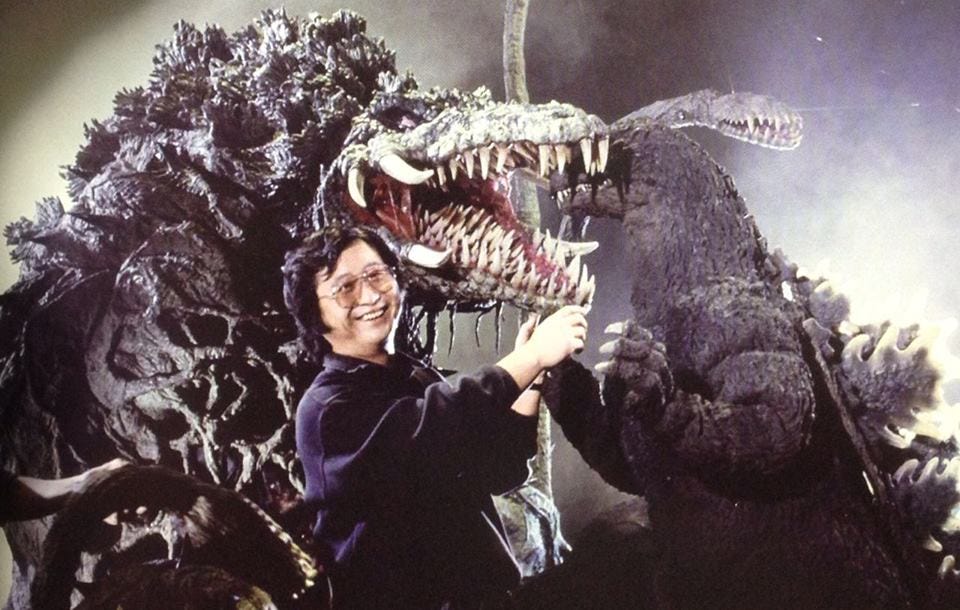

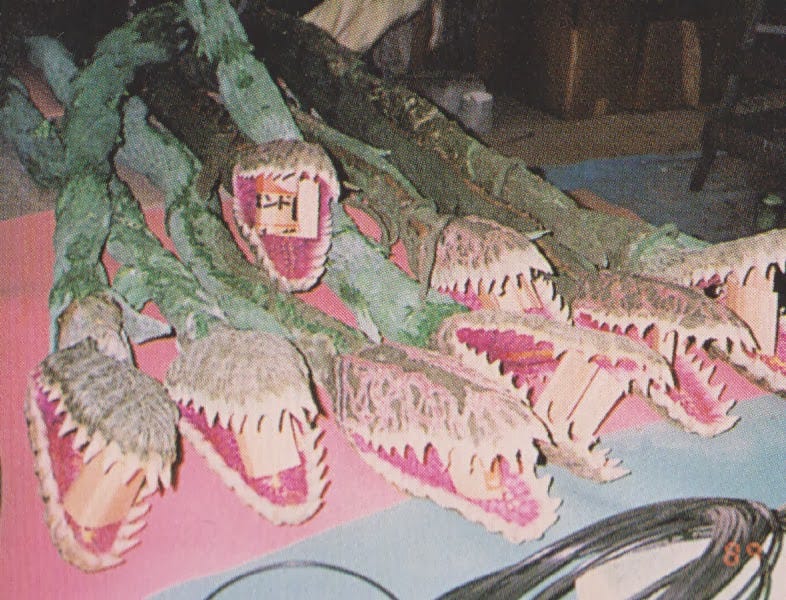
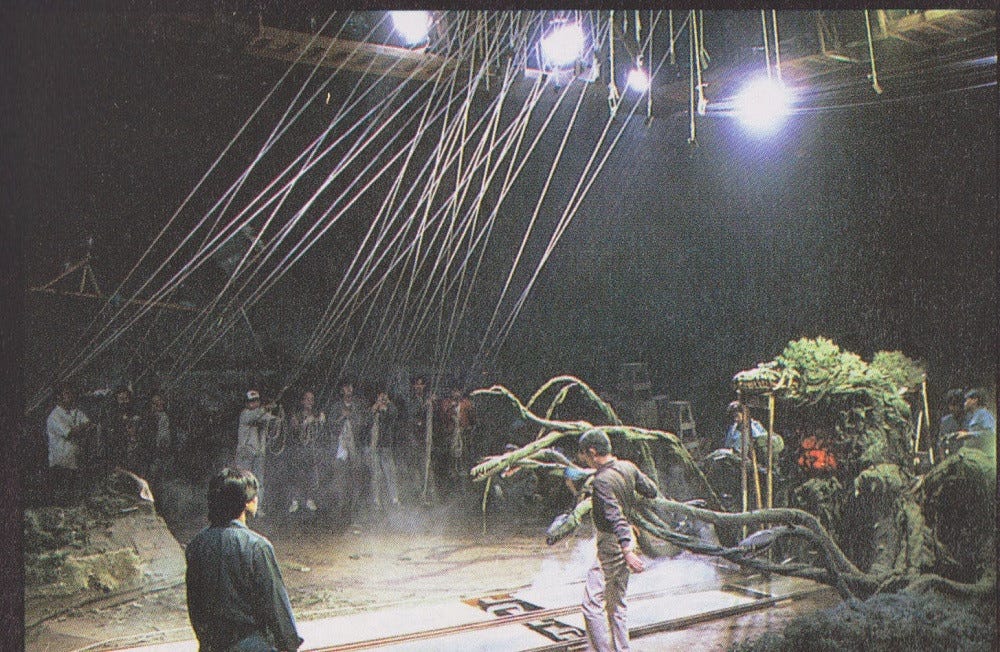

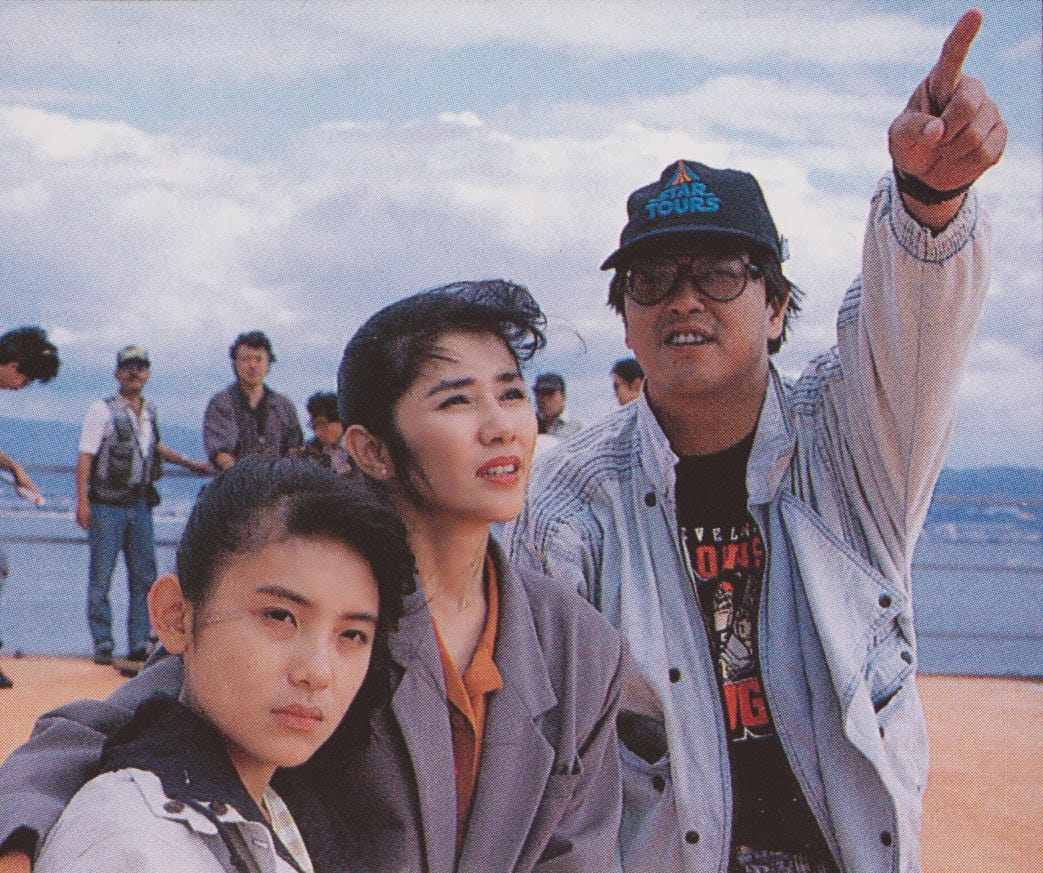


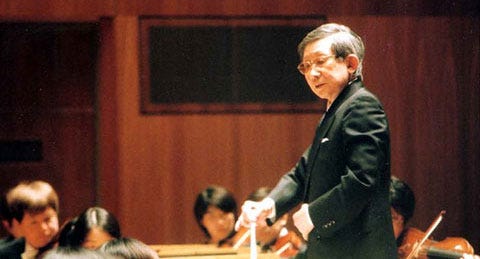
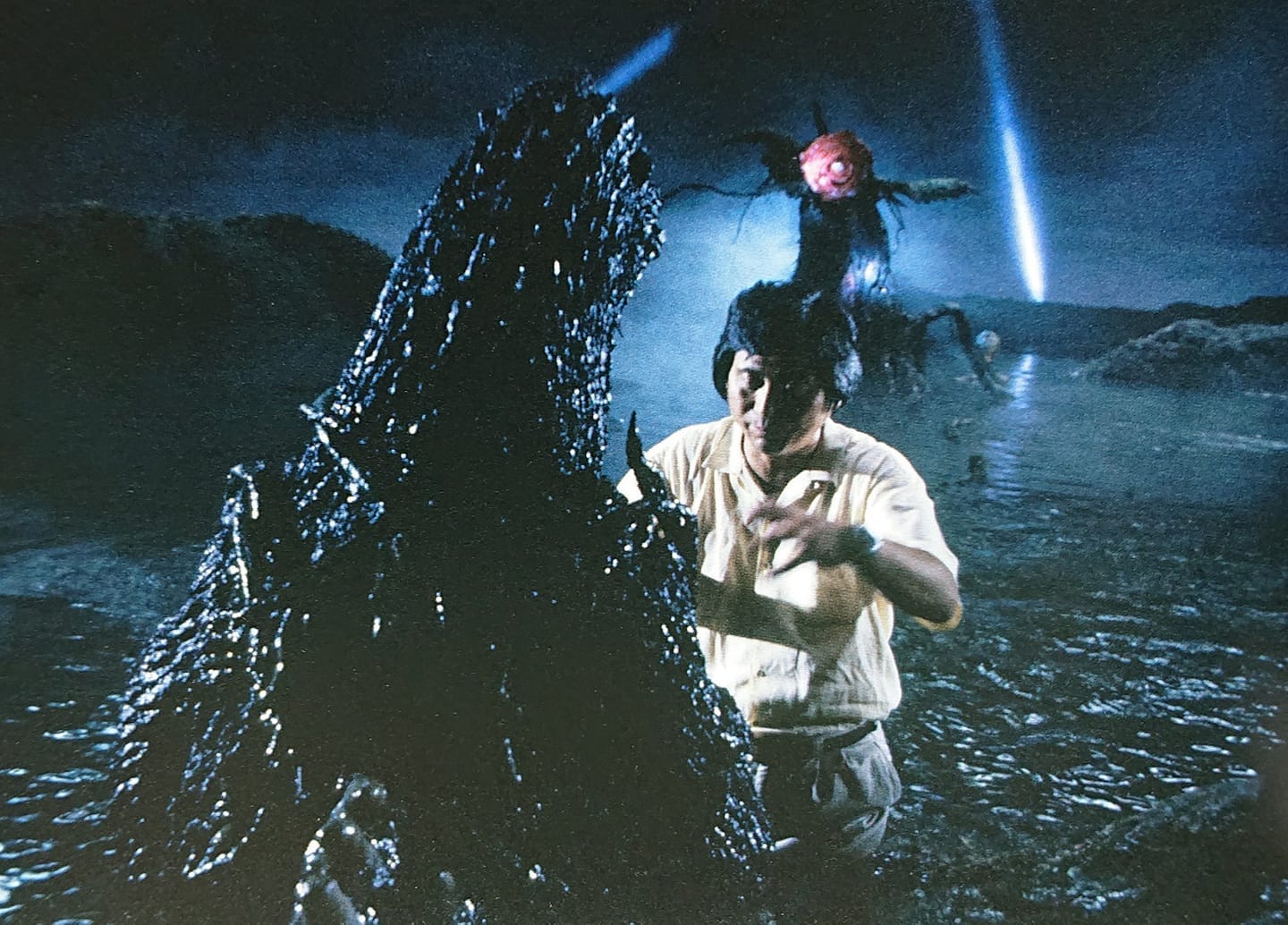
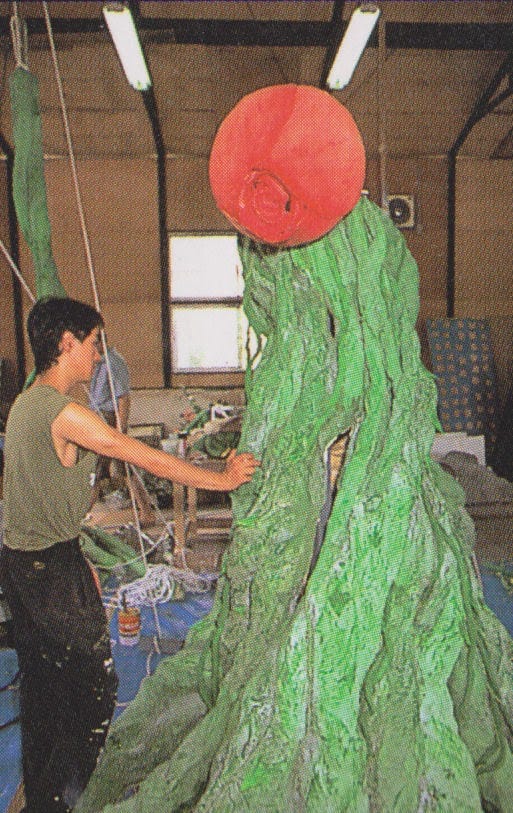
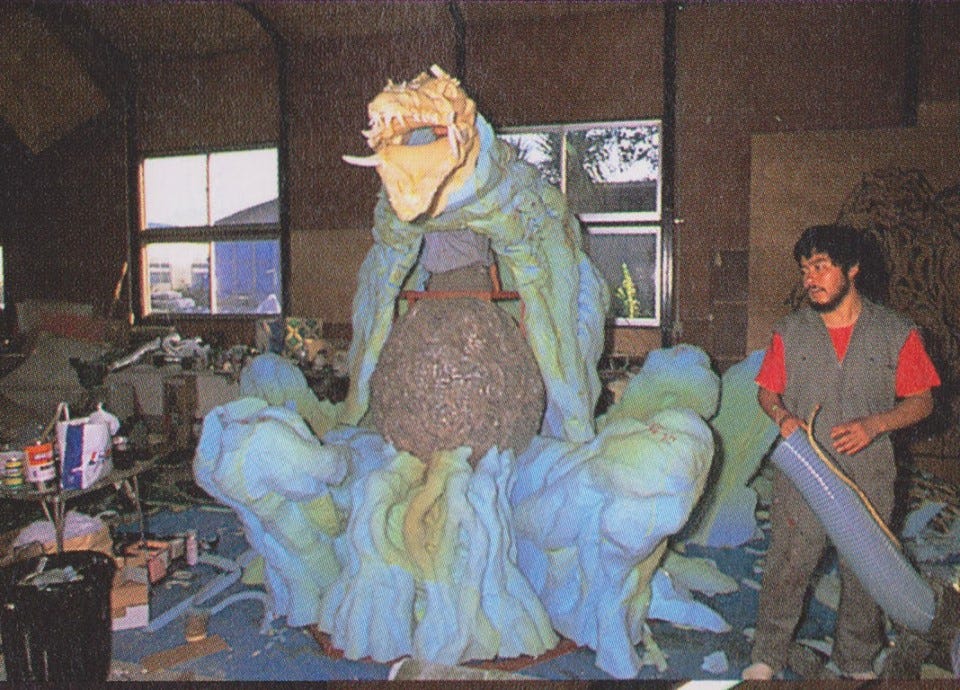


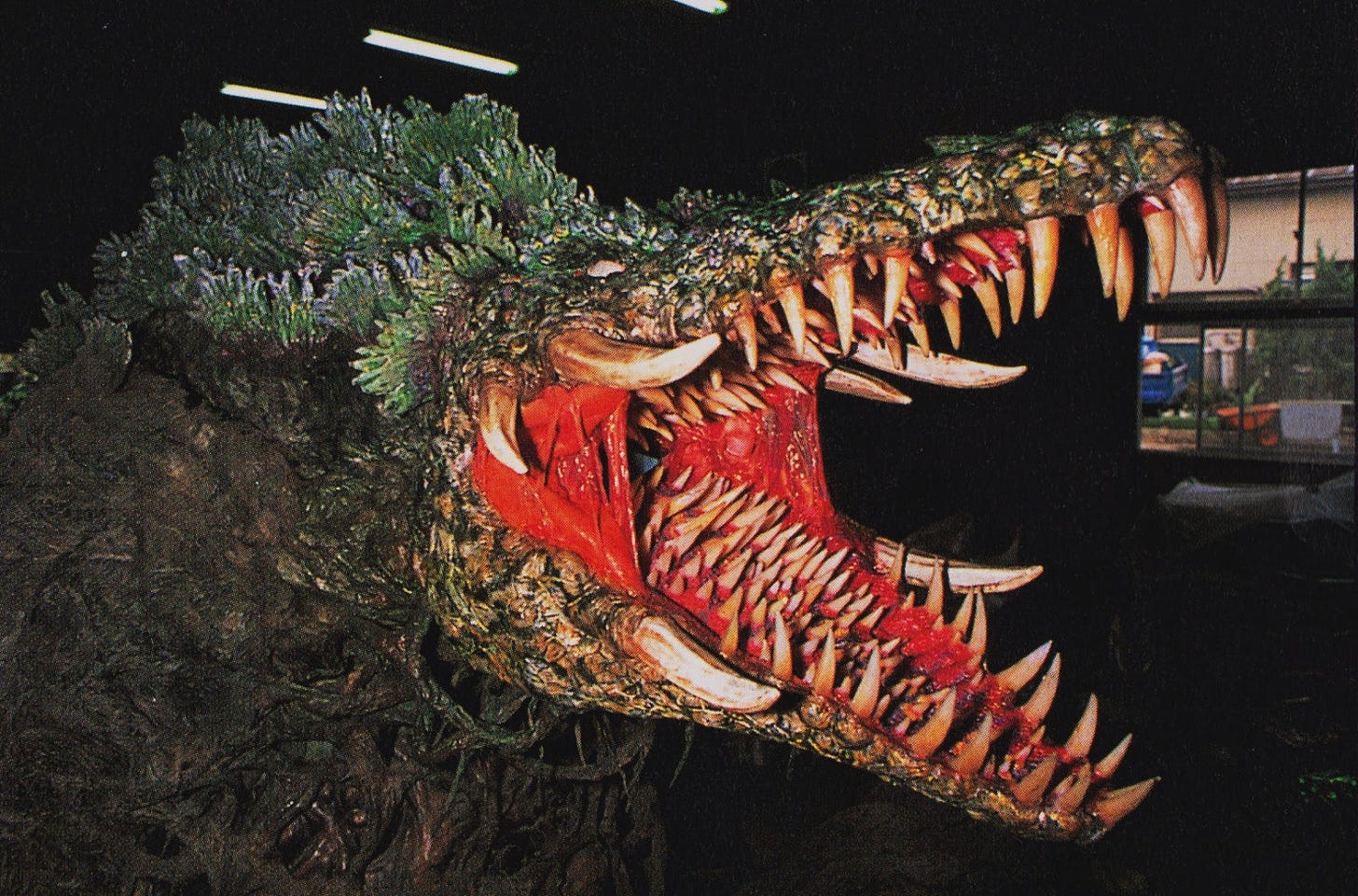
too long, didn't read